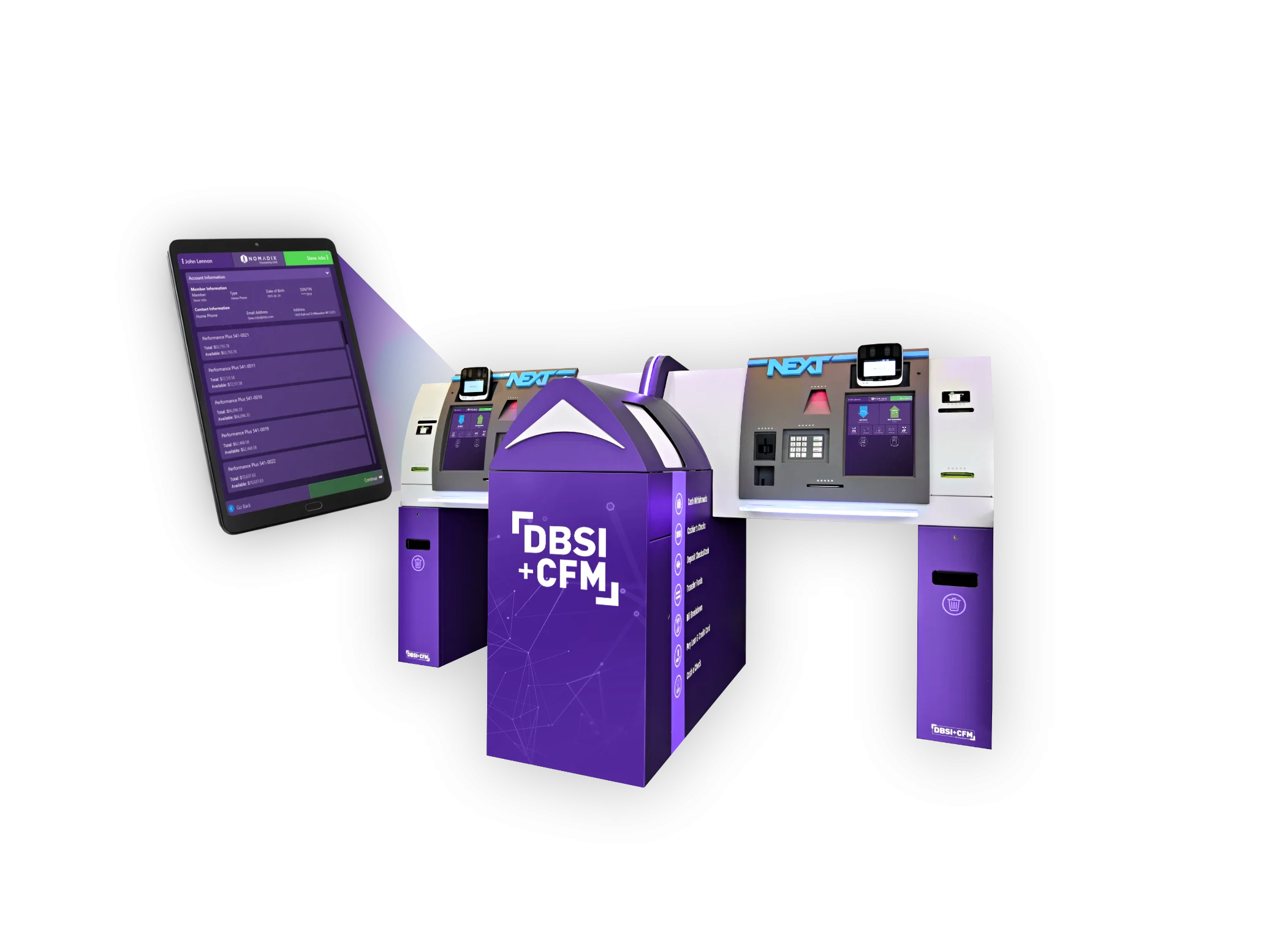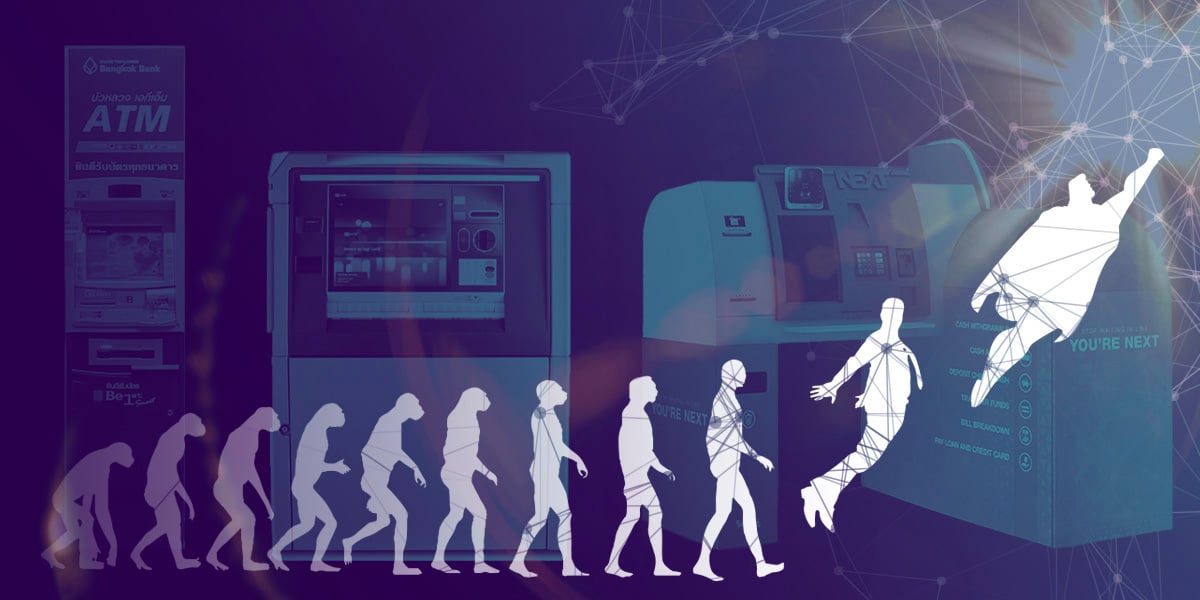It’s Time to Roar from the Stone Age to the Digital Age with ATMs, ITMs, and Integrated Kiosks
In the Stone Age of banking, clients waited in line (and waited in line) for teller service, from simple cash transactions and check deposits to account transfers and appointment requests. Time passed and technology evolved. The dinosaur-like processes of banking began to reach extinction—and in their place—digital technology emerged, ready for the next generations of banks, credit unions, and clients.
What age is your financial institution in?
No matter where you’re at with network operations, Kinective can help speed your bank or credit union into a new era with integrated, self-service solutions that work!
How Did Self-Service Solutions Evolve?
ATMs – In the mid-1960s, inventor John Shepherd-Barron came up with an idea for a cash machine that could dispense money like a vending machine dispenses candy. After security improvements by other inventors, Barclays Bank installed the first operational cash machine in London. Today, over 3 million ATMs are used across the globe. They’ve come a long way too; “smart ATMs” now have face recognition and offer things like check cashing, money transfer, and real-time bill-paying options. ROAR!
ITMs – The Interactive Teller Machine has been around for over a decade. With an ATM-like interface, this dynamic machine is also known as a “branch in a box” and has all the capabilities of an ATM plus a video screen that allows live access to human representatives. In 2013, Bank of America introduced ITMs in Boston as “ATMs with Teller Assist.” Used today by 25% of financial institutions, 60% of financial institutions plan to integrate ITMs into their operations within the next few years. DOUBLE ROAR!
Integrated Kiosks – A few steps up from the ITM, integrated kiosks are full-service transaction stations that can essentially replace live teller service. Besides having all the functionalities of the ATM and ITM, they can print out account histories, make change to the penny, and much more. When an integrated kiosk such as DBSI’s NEXT is paired with Kinective’s CFM core integration technologies like Genix and Nomadix, financial institutions are able to remote-assist at integrated kiosks for most banking transactions.
We’re Done Caving! What Can Self-Service Solutions Help Us Do?
- Decrease your high-cost, low-value transactions. With the growth of digital banking solutions and the popularity of self-service transactions today, it’s possible to replace FTE with technology and save your bank or credit union network a significant amount of capital over time. The consulting firm Bancography stated that ITM-using institutions they surveyed were able to establish one call center for every 2.4 machines and were subsequently able to reduce overall staff levels. Research by Cornerstone Advisors indicated that ITMs only cost financial institutions between 50 and 70 cents per transaction, while in-person teller transactions cost $4.50 each. That’s a significant savings!
- Serve more clients outside of traditional business hours. Today’s banking clients expect faster service, and service available to them 24 hours a day. In fact, according to a recent Forbes-Ipsos survey, over three-quarters of Americans prefer to bank digitally; it allows them to bank from anywhere at any time using a computer or mobile device. And that’s good news for self-service banking solutions because clients are becoming accustomed to banking on their own! Self-service solutions can operate outside of normal branch banking hours (with the use of remote call center staff) and can be placed offsite, at drive-thru locations, or in after-hours entryways.
- Implement or Support the Universal Associate (UA) Model. Not only is the addition of self-service solutions a great benefit for your clients, it’s also a great opportunity for your team to build or modify the Universal Associate (UA) Model at your branch locations. Sometimes called Universal Bankers or Universal Tellers, Universal Associates (UAs) are often trained well beyond teller-level duties to conduct needs-based selling, process loans, conduct branch marketing campaigns, and act as brand ambassadors.
By adding self-service solutions to your branch banking infrastructure, you can reduce wait lines at your teller stations and free up staff for more advisory-based conversations that lead to higher-level sales. Statistics show that ATMs and other solutions are popular with clients too; in 2020, a survey by Mercator Advisory Group found that consumers made 4.4 ATM visits per month to get cash, and 2.8 visits per month to deposit cash. Imagine how adding ITMs or integrated kiosks to your branches could change your traffic patterns!
- Make Your Branch Footprint Shrink. During the pandemic, you likely made some major changes to your bank or credit union operations to comply with laws and locate mandates. Drive-thru-only service, additional mobile banking options, and even branch closures were seen worldwide across many industries. This new modus operandi prompted many financial institutions to rethink how their branches would operate in the future, in light of evolving consumer behaviors.
If you’re thinking about downsizing your branch locations or you’re operating with fewer employees, self-service solutions are the perfect way to provide quality service with less FTE and physical space. It’s even possible to increase your market presence when you place self-service solutions offsite in underserved geographical areas.
Roar Into the Future with Kinective’s CFM!
After learning the ways self-service solutions can help your bank or credit union, are you unsure whether you need them? Ask yourself the following questions:
- Do we need to modernize our in-branch experience?
- Should self-service go beyond ATM machines?
- Do we want a full choice of hardware solutions now and in the future?
- Do we have cash recyclers or do we want to add them?
If you answered “yes” to any of these questions, your financial institution should implement self-service solutions. Kinective can walk you through the analysis steps, review your goals, and help you decide which machines and technologies will best be suited for your market spaces.
You can contact us here to get more information and then explore our website to learn more about our products!
Article updated May 2024
